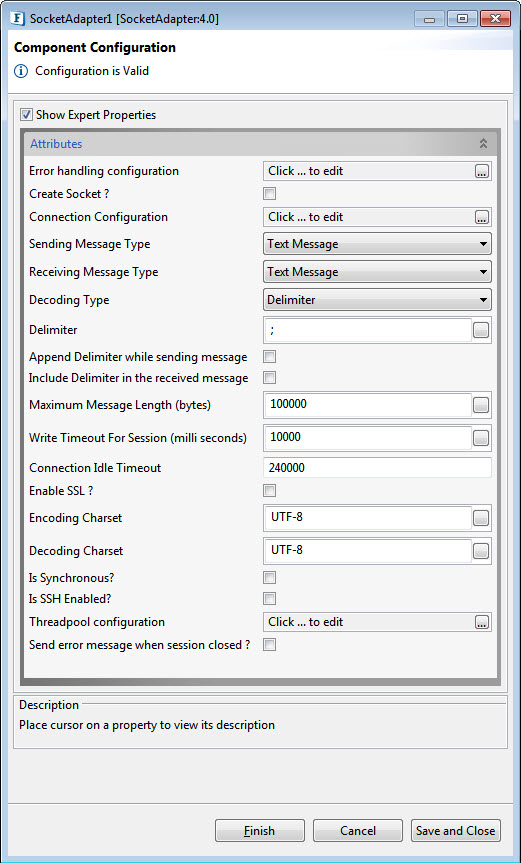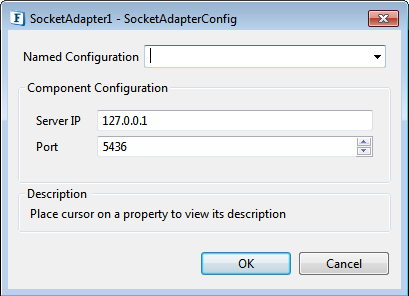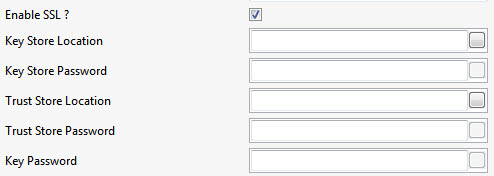...
Configuration attributes in the SocketAdapter Configuration Property Sheet (CPS) with Expert Properties enabled are explained below.


Figure 1: SocketAdapter Configuration CPS
...
Enable - Acts as a server by creating a socket on the specified port and listens to client connections
Note Enabling this property
- disables the properties Connection Idle Timeout and Is Synchronous? too.
- makes the following properties property available for configuration:
Disable - Acts as a client assuming that the server is already running on the specified port and connects to it.
...

Figure 2: Connection Configuration dialog box
Sending Message Type
Mode of the message transfer while sending a message is classified as below:
- Text Message: Messages will be encoded and decoded as Stringsstring.
- Byte Message: Messages will be encoded and decoded as bytes.

Figure 3: Message Type options
| Info |
|---|
Sending Message Type and Receiving Message Type are the two Messages Types to be configured for the messages that you send and receive respectively.to be sent and received respectively. |
Receiving Message Type
Mode of the message transfer while receiving a message is classified as below:
- Text Message: Messages will be decoded as string.
- Byte Message: Messages will be decoded as bytes.
DecodingType
Messages received in the communication will be decoded in the following ways.
- Delimiter: Messages are decoded based on the delimiter configured.
- Length: Messages are decoded based on the length of the message.
- None: All the messages present in the stream are fetched.
- ISO: Messages are decoded based on the ISO standards.
Delimiter decoding type
| Info |
|---|
If the Decoding Type property value is 'Delimiter', then the following properties will be visible,
The Decoding Type is set to 'Delimiter' by default. |
Delimiter
Delimiter is to be used as an end of the message.
...
| Note |
|---|
|
Length decoding type
If enabled, messages will be decoded based on the length of the message.
...
This property is given by the number of bytes. For the Message Type 'Text', for UTF-8 charset:1 char is 1 byte; for UTF-16 charset: 1 char is 2 bytes.
ISO decoding type
| Info |
|---|
If the Decoding Type property value is 'ISO', then the following properties will be visible above the Decoding Type property,
|
...
| Note |
|---|
This property is visible only when the Message Length Numeric Type property is set to either 'Hexadecimal' or 'Decimal'. |
Includes Header Length
Select this property if the Header length (in bytes) needs to be included in the input message.
Write Timeout for Session (milliseconds)
...
The actual time taken to close the idle connections will be between the configured time and double that time. The default value is 240000 milliseconds.
Enable SSL?
By enabling SSL and providing the required key store/trust store with respective passwords, secure message transfer can be achieved.

Figure 7: SSL Configuration
Encoding Charset
The Charset, such as UTF-8, used while encoding the message.
Decoding Charset
The Charset, such as UTF-8, used while decoding the message.
Is synchronous?
Synchronous communication happens between a client and the server. Messages from the client are sent to the server till the client receives a response and if no response is received from the server till the given Suspend Timeout (gets visible when this property is enabled), then a timeout message is sent to the exception port and the next request is processed. Suspend Timeout (gets visible when this property is enabled), then a timeout message is sent to the exception port and the next request is processed.

Figure 6: Synchronous Communication options
| Note |
|---|
This property is enabled for Client only. It isSo, it will be visible only when Create Socket ? property is disabled , for Client. |
Suspend Timeout (milli seconds)
If the message sent by a client takes more time than the Suspend Timeout to execute, then the next message is sent.
| Note |
|---|
This property is visible only when IsSynchronous? property is disabled, for Client. |
Enable SSL?
By enabling SSL and providing the required key store/trust store with respective passwords, secure message transfer can be achieved.

Figure 7: SSL Configuration
IsSSHIs SSH Enabled?
If Enabledenabled, the communication will take place through a secured channel; only if the server authenticates itself to the client through Key Pair and the client authenticates to the server using an SSH login name and password.
...
User Name for the SSH Session, used by the client to authenticate itself to the server
SSHSSH Password
Password for the SSH Session, used by the client to authenticate itself to the server
IsIs KeyPairPair Needed
This is a property present at the Client side. If enabled, it specifies that the client needs to communicate with the server authenticated by a specified Key Pair. If disabled, the client will accept any server key pairs.
KeyPairKey Pair Path
Key pair should be provided at runtime by the user at both client side and the server side for proper authentication. A key pair in ".pem" format is required by the SSH library to perform the key exchange and verification.
...
| Tip | ||
|---|---|---|
| ||
|
...
